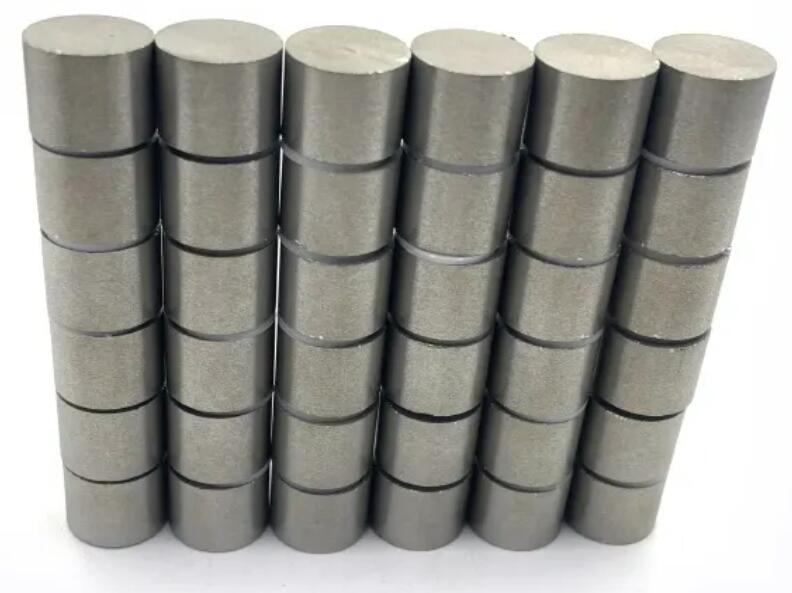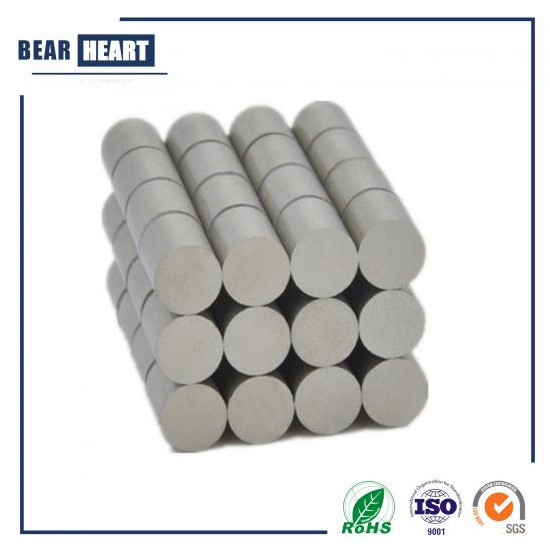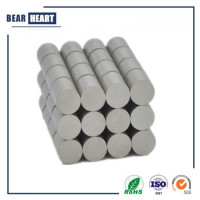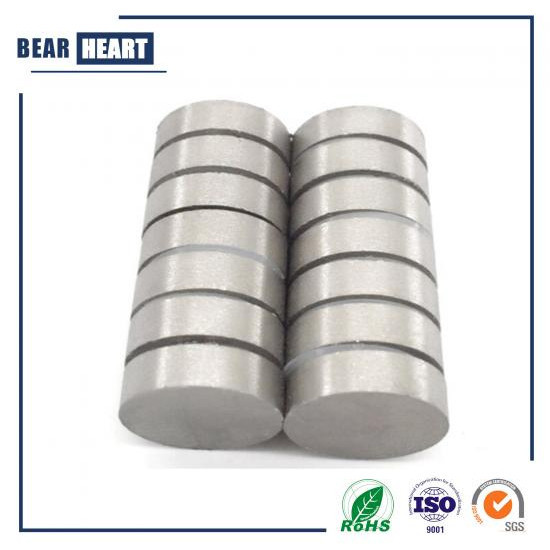
Rare earth SmCo disc Magnet supplier
Specifications
1. SmCo magnet, permanent magnet, rare earth magnet
2. Excellent resistance to corrosion, high working temperature.
Our SmCo Magnet can be produced in a variety of shapes sizes and grades as part of our SmCo magnets (made-to-order) custom service.
- Information
China Supplier Customize Sintered SmCo Disc Magnets
Samarium Cobalt (SmCo) disc magnets are powerful magnets rare earth magnets composed of samarium and cobalt. They are commonly used in high performance motors, magnetic couplings and magnetic separators. These are brittle magnets and are prone to cracking and chipping. Samarium magnets can be used for high temperature applications where neodymium will not work.


Basic Magnetic Property:
Maximum working temperature: 250-350°C
Maximum Energy Product: (Bhmax)(15-35 MGOe)
Maximum Working Temperature: (Temp.Tw) 250-350
Induction Coercive Force: (Hcb) 4-12(Koe)
Residual Magnetism: Br 0.8-1.2(T)
Reversible temperature coefficient of residual magnetism (Br) -0.04 --- -0.01
SmCo Magnets – SmCo5 & Sm2Co17
Samarium Cobalt (SmCo) disc magnets are the second generation of rare earth permanent magnets, it is made of samarium, cobalt and other rare earth metal. Bearheart can provide SmCo5 and Sm2Co17 magnets in various shapes.
Production Process of Samarium Cobalt Permanent Magnet:
Powder process→ Pressing→ Sintering → Magnetic property test → cutting → finished products
Samarium cobalt materials are commonly processed under un-magnetized circumstances, with diamond grind wheel and wet fine grinding, which is necessary. Because of the low ignition temperature, samarium cobalt must not be dry completely. Just a small spark or static electricity in production can easily trigger a fire, with extremely high temperature, which is hard to control.
Technical data of SmCo Magnet
Material | Grade | Energy Product(BH)max | Residual Induction Br(min-max) | Coercive Force Hcb(min-max) | Intrinsic Coercive Force Hcj(min-max) | Density D | Rev. Tenp Coeff α(Br) | Curie Temp TC | Max Working Temp Tw | ||||
KJ/m 3 | MGsOe | T | KGs | KA/m | KOe | KA/m | KOe | g/cm 3 | %/ºC | ºC | ºC | ||
SmCo5 | XG16 | 120~143 | 15~18 | 0.77-0.86 | 7.7-8.6 | 613-716 | 7.7-9.0 | ≥1194 | ≥15.0 | 8.3 | -0.04 | ≥740 | 250 |
XG16H | 120~143 | 15~18 | 0.77-0.86 | 7.7-8.6 | 613-716 | 7.7-9.0 | ≥1592 | ≥20.0 | |||||
XG18 | 135~159 | 17~20 | 0.81~0.92 | 8.1~9.2 | 637~756 | 8.0~9.5 | ≥1194 | ≥15.0 | |||||
XG18H | 135~159 | 17~20 | 0.81~0.92 | 8.1~9.2 | 637~756 | 8.0~9.5 | ≥1592 | ≥20.0 | |||||
XG20 | 151~175 | 19~22 | 0.85~0.95 | 8.5~9.5 | 637~756 | 8.0~9.5 | ≥1194 | ≥15.0 | |||||
XG20H | 151~175 | 19~22 | 0.85~0.95 | 8.5~9.5 | 637~756 | 8.0~9.5 | ≥1592 | ≥20.0 | |||||
XG22 | 167~191 | 21~24 | 0.89~1.0 | 8.9~10.0 | 661~772 | 8.3~9.7 | ≥1194 | ≥15.0 | |||||
XG22H | 167~191 | 21~24 | 0.89~1.0 | 8.9~10.0 | 661~772 | 8.3~9.7 | ≥1592 | ≥20.0 | |||||
Sm2Co17 | XGS24M | 175~199 | 22~25 | 0.92~1.04 | 9.2~10.4 | 318~788 | 4.0~9.9 | 398~1194 | 5.0~15.0 | 8.4 | -0.03 | ≥850 | 350 |
XGS24 | 175~199 | 22~25 | 0.92~1.04 | 9.2~10.4 | 661~796 | 8.3~10.0 | 1194~1990 | 15.0~25.0 | |||||
XGS24H | 175~199 | 22~25 | 0.92~1.04 | 9.2~10.4 | 661~804 | 8.3~10.1 | > 1990 | > 25.0 | |||||
XGS26M | 191~215 | 24~27 | 1.0~1.06 | 10.0~10.6 | 318~796 | 4.0~10.0 | 398~1194 | 5.0~15.0 | |||||
XGS26 | 191~215 | 24~27 | 1.0~1.06 | 10.0~10.6 | 677~820 | 8.5~10.3 | 1194~1990 | 15.0~25.0 | |||||
XGS26H | 191~215 | 24~27 | 1.0~1.06 | 10.0~10.6 | 677~820 | 8.5~10.3 | > 1990 | > 25.0 | |||||
XGS28M | 207~231 | 26~29 | 1.04~1.10 | 10.4~11.0 | 318~804 | 4.0~10.1 | 398~1194 | 5.0~15.0 | |||||
XGS28 | 207~231 | 26~29 | 1.04~1.10 | 10.4~11.0 | 677~820 | 8.5~10.3 | 1194~1990 | 15.0~25.0 | |||||
XGS28H | 207~231 | 26~29 | 1.04~1.10 | 10.4~11.0 | 677~820 | 8.5~10.3 | > 1990 | > 25.0 | |||||
XGS30M | 223~247 | 28~31 | 1.07~1.12 | 10.7~11.2 | 318~804 | 4.0~10.1 | 398~1194 | 5.0~15.0 | |||||
XGS30 | 223~247 | 28~31 | 1.07~1.12 | 10.7~11.2 | 700~828 | 8.8~10.4 | 1194~1990 | 15.0~25.0 | |||||
XGS30H | 223~247 | 28~31 | 1.07~1.12 | 10.7~11.2 | 700~828 | 8.8~10.4 | > 1990 | > 25.0 | |||||
XGS32M | 231~255 | 29~32 | 1.09~1.15 | 10.9~11.5 | 318~804 | 4.0~10.1 | 398~955 | 5.0~12.0 | |||||
XGS32 | 231~255 | 29~32 | 1.09~1.15 | 10.9~11.5 | 716~836 | 9.0~10.5 | > 955 | > 12.0 | |||||
Low Temp Coeff Sm2Co17 | XGS22LT | 159~183 | 20~23 | 0.90~0.99 | 9.0~9.9 | 677~756 | 8.5~9.5 | ≥1194 | ≥15.0 | 8.4 | -0.015 | ≥850 | 350 |
Samarium Cobalt Disc Magnets Application:
SmCo permanent magnets have a strong resistance to corrosion and oxidability, which are widely applied to aviation, and aerospace, national defense and military industry, microwave components, communication, therapy equipments, instruments, apparatus, various kinds of magnetic transmission devices sensors, magnetic processer, motor and magnetic lifting machines.
FAQ:
Q1. What is a Rare Earth SmCo disc magnet?
A1. A Rare Earth SmCo disc magnet is a cylindrical shaped rare earth magnet made from an alloy of samarium and cobalt. It is characterized by its high magnetic strength and temperature stability.
Q2. What are the characteristics of a Rare Earth SmCo disc magnet?
A2. Rare Earth SmCo disc magnets have high magnetic strength, excellent temperature stability, and high resistance to demagnetization. They are brittle and relatively expensive compared to other types of magnets.
Q3. What are the applications of Rare Earth SmCo disc magnets?
A3. Rare Earth SmCo disc magnets are used in various industrial applications, including sensors, motors, actuators, and generators, as well as in medical and scientific equipment.
Q4. How are SmCo magnets stored and handled?
A4. SmCo magnets should be stored away from other magnets and electronic devices, as they can interfere with their proper functioning. They should also be handled carefully to avoid cracking or chipping.
Q5. What are the safety precautions for SmCo magnets?
A5. Care should be taken when handling SmCo magnets to avoid injuries from the strong magnetic field. They should also be kept away from electronic devices, pacemakers, or other medical devices that can be affected by their magnetic fields.









